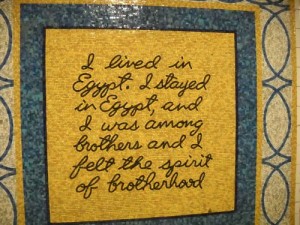We didn’t end up in Brooklyn or something.
We didn’t get mugged.
We didn’t even get our pockets picked.
On the whole, taking the subway in New York City was a pretty pleasant experience. Now, Alex and I weren’t subway newbies or anything. Our first subway was the London Underground in 2002 (though Alex was too little to remember it) and then the subway in Toronto in 2003 (he doesn’t remember that one, either). Alex does remember taking the Metro in Washington, DC and the subway in Rome in 2014, though. But this was the New York City subway, which movies and television make look forbidding and dangerous. It may have been just the stations we went to, but we did end up going through (or, well, under) Jamaica and Queens (and we saw more of the bottom of Queens than we expected) and it was not terrifying, like I half-feared it would be. I could even see myself doing this on a regular basis, if I ever could get a job that would support me in New York City.

I was often nervous when we got on a train, but that was mostly because of the existence of part-time train stations and express lines. I was always afraid that we’d get on, say, a train that had a big B on the front at Cathedral Parkway (something that totally did happen) and it would turn out that this particular B train skips the Bryant Park station completely and we would have to get off at Herald Square or Washington Square and make our way back to our hotel from there somehow. This, of course, never happened. Nearly every time we got on the subway, we got off at the stop where we were supposed to get off.
The “nearly” was our last day in New York. We were taking the subway back to JFK. While we were waiting on the platform for the E train, we heard “mumble mumble eee.” It was an “e” sound, so it could have been E, or B, or C, D, G, P, Z, or 3. Soon enough, an E train comes along, and we get on. After a few stops, though, the lighted map thing on the wall turns off and the train heads off the wrong direction. Turns out all that mumbling was the announcement that the next E train was actually going to be an M train. Fortunately, the E and M trains intersected another few stops down, so we got off the M train there, and caught the next E train, which stayed an E train this time, and we got back to the airport with something like three hours to spare. So that was our heart-stopping side trip into Queens. So for next time, if I hear some kind of announcement that might have something to do with my train, I will ask.
Some New York City subway stations are wheelchair accessible. Many of the ones we used were not, but some, including the stations in Queens leading to and from JFK were.

